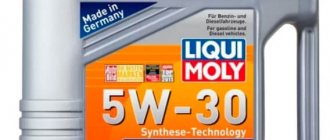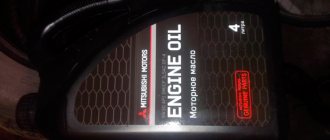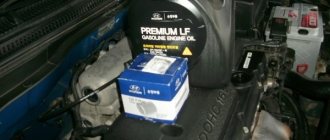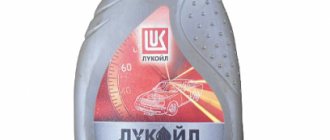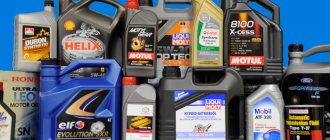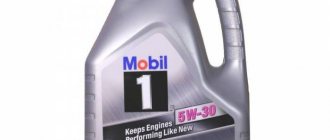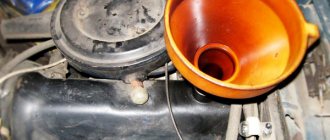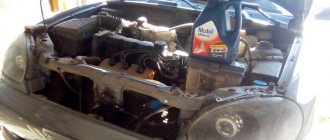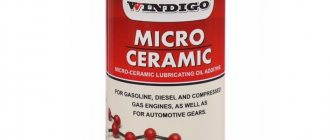- home
- Brands
- Toyota
07.07.2020
Toyota Yaris is a compact B-class car, produced in a hatchback body. Production began in 1999. In Japan they offered a similar model called Vitz. The hatchback of the same name, which replaced the Toyota Starlet, rolled off the assembly line in France in Europe. The car turned out to be so popular that in 2000 it was awarded the title “European Car of the Year”. The Yaris production model was preceded by three concept cars presented at the 1997 Frankfurt Motor Show - the Funtime hatchback, the Funcoupe coupe and the Funcargo van. The prototypes embodied a universal platform, which was later approved by the Toyota concern, after which the development of a production model began in the Japanese and European divisions.
How much oil to fill in a Toyota Yaris engine
First generation (XP10, model year – 1999-2006)
The 1999 Yaris featured noticeable changes in design and technology compared to its predecessor, the Starlet. The taller body allows for an upright seating position, which has a positive effect on interior space front and rear. In addition, the hatchback began to look impressive from the front due to larger optics and a radiator grille. But on the other hand, the car has lost the sporty image of a small hatchback. Therefore, it is not surprising that at the start the car was equipped with modest 1.0 (65 hp) and 1.3 liter (86 hp) engines, coupled with a manual transmission or “robot”, as well as a 4-speed “automatic”. Later, a 75-horsepower 1.4 diesel engine became available, as well as a 1.5-liter gasoline engine (105-106 hp). In 2003, there were minor changes in the exterior and engine range. In the USA, the Echo sedan was also offered based on the hatchback. In addition, the Yaris line included the Verso compact van.
Also read: Automatic transmission oil for Toyota Camry
Gasoline engines 1999-2005
- 1SZ-FE 1.0, oil volume – 2.9 liters, tolerance and viscosity: SJ/GF-2, from 12.2001 – SL/GF-3; 5W-20
- 2SZ-FE 1.3, oil volume - 3.1 liters, tolerance and viscosity: SJ/GF-2, from 12.2001 - SL/GF-3; 5W-20
- 2NZZ-FE 1.3, oil volume - 3.4 liters, tolerance and viscosity: SJ/GF-2, from 12.2001 - SL/GF-3; 5W-20
- 2NZ-FE 1.5, oil volume - 3.4 liters, tolerance and viscosity: SJ/GF-2, from 12.2001 - SL/GF-3; 5W-20
Diesel engines 1999-2005
1ND-FE 1.4, oil volume - 3.1 liters, tolerance and viscosity: CF; 5W-30
Second generation (XP90, model year – 2005-2013)
The 2005 Yaris received an even taller body, which is why it radically moved away from its youth image. The car retained its compact dimensions and was popular in Europe, where there has always been a strong demand for city cars. In addition, the second generation Yaris was delivered to North America, Australia and Asia, while in Japan the Vitz designation was retained. In 2006, sales of the 4-door Yaris sedan, also known as Belta or Vios, began sales in some countries. The Yaris II engine range included more powerful engines of 1.0, 1.3, 1.5 and 1.6 liters, as well as a 130-horsepower 1.8 for the small-scale Yaris RS hot hatch. A 90-horsepower 1.4-liter diesel engine was also available. Until 2010, the car was offered on the Russian market, and only with a 1.3-liter engine (87-101 hp).
Gasoline engines
- 1SZ-FE 1.0, oil volume – 2.9 liters, tolerance and viscosity: SJ/GF-2, from 12.2001 – SL/GF-3; 5W-20
- 2SZ-FE 1.3, oil volume - 3.1 liters, tolerance and viscosity: SJ/GF-2, from 12.2001 - SL/GF-3; 5W-20
- 2NZZ-FE 1.3, oil volume - 3.4 liters, tolerance and viscosity: SJ/GF-2, from 12.2001 - SL/GF-3; 5W-20
- 2NZ-FE 1.5, oil volume - 3.4 liters, tolerance and viscosity: SJ/GF-2, from 12.2001 - SL/GF-3; 5W-20
Also read: Motor oil for Nissan March engine
Diesel engines 1999-2005
1ND-FE 1.4, oil volume - 3.1 liters, tolerance and viscosity: CF; 5W-30
Third generation (XP130, model year – 2011-2019)
The 2011 Yaris hatchback, in terms of design, was already more associated with the squat Starlet, which it replaced back in 1999. Moreover, the third generation Yaris has completely moved away from the image of a practical and family car. There have been dramatic changes in design.
Thus, the hatchback began to look impressive due to the massive and “evil” radiator grille. Yaris III was supplied to Europe, North America and Australia, but the car was not sold in Russia due to low demand for such city cars. The three- and five-door hatchbacks of the same name rolled off the assembly line with a base 69-horsepower 1.0-liter engine, as well as a more top-end 1.5-liter engine (111 hp). For the first, a manual transmission was provided, and a 111-horsepower internal combustion engine was combined with a CVT. In addition, a hybrid version was released with a total output of 100 horsepower. In 2021, an economical 90-horsepower 1.4-liter diesel engine became available. The first batch of “charged” Yaris GRMN hatchbacks with a 1.8-liter turbo engine producing 210 hp has also gone on sale. With.
Gasoline engines
- 1SZ-FE 1.0, oil volume – 2.9 liters, tolerance and viscosity: SJ/GF-3-4, API – SN; 5W-30
- 2NZ-FE 1.5, oil volume - 3.4 liters, tolerance and viscosity: SJ/GF-3-4, API - SN; 5W-30
Diesel engines 1999-2005
1ND-FE 1.4, oil volume - 3.1 liters, tolerance and viscosity: CF; 5W-30
Fourth generation (MXPH15, year of manufacture – from 2020)
The 4th generation Yaris is a completely new car compared to previous models. The new hatchback is designed in a coupe-like style, but without sacrificing space for rear passengers. However, the manufacturer himself does not hide the fact that the fourth Yaris was created primarily for two. The car captivates with its sporty image, especially in the version with a red body, black roof and radiator grille. The compact hatchback is intended for sale in Europe and Japan, and its production is carried out in France. The model is available with 1.0 and 1.5 liter engines, with a power of 69 and 120 hp. With. respectively. The engines operate with a manual transmission or a CVT. There is also a hybrid installation based on a 1.5 liter internal combustion engine and an electric motor, developing 116 “horses”. The hatchback with all-wheel drive is sold only in Japan.
Also read: Motor oil for Ford Ecosport engine
Gasoline engines
- 1SZ-FE 1.0, oil volume – 2.9 liters, tolerance and viscosity: SJ/GF-3-4, API – SN; 5W-30
- 2NZ-FE 1.5, oil volume - 3.4 liters, tolerance and viscosity: SJ/GF-3-4, API - SN; 5W-30
Toyota Yaris engine oil
The recommended engine lubricant is Toyota Genuine Motor Oil API SL. The fluid ensures optimal operation of the power plant and a sufficient degree of protection against premature wear.
Regarding viscosity, mixtures such as SAE 5W40 or 0W30 are applicable here. The final choice of lubricant thickness depends on temperature thresholds and the climatic zone of operation of the vehicle.
If the necessary modification is not available in store warehouses, you can select analogues according to the following specifications.
API
According to API standards, oil in Toyota Yaris is selected to be of a category not lower than SL.
Liquids that fall under the standards of the certificate are distinguished by their compatibility with turbocharging systems, highly accelerated engines running on lean mixtures.
API SL oils are characterized by reduced emissions of harmful substances into the atmosphere and fuel economy.
The basis
Three types of formulas are used as the basis for modern lubricants:
Note! The information provided is for informational purposes only. The final choice of lubricant manufacturer depends on the personal preferences of the user.
What kind of oil to fill in the Toyota Yaris engine
Original
Toyota Yaris owners are recommended to use Toyota Genuine Motor Oil API SL branded engine oil with a viscosity of 5W-40 and 0W-30, which is most preferable for Russian operating conditions.
Unoriginal
If the car is second-hand or it is not possible to buy the original, then you should prefer a high-quality analogue that meets the parameters of the branded oil. When choosing an analogue from its most significant characteristics, it is important to pay attention to the API approval - SL, as well as the type of liquid - synthetic or semi-synthetic. In addition, the viscosity of SAE 5W-40 or 0W-30 is important. You can choose from the following lubricants:
- Liqui Moly Leichtlauf High Tech 5W-40
- Lukoil Genesis Glidetech 5W-30
- Motul 8100 Eco-Clean 0W-30
- Mobil Full Synthetic 5W-30.
What kind of oil should be poured into the Toyota Yaris engine
Original
The Toyota Yaris engine requires original Toyota Engine Oil SN 0W-30 or Toyota Motor Oil SN 0W-20. Oil viscosity depends on environmental conditions. For example, it is mainly recommended to use SAE 20W-40 or 25W-50 in summer, and in winter it is better to choose 0W-40, 0W-30 or 5W-30. If the car is driven all year round, then the manufacturer recommends all-season oil 10W-40, 10W-30 or 5W-40.
Unoriginal
Owners of old and used Toyota Yaris of the first previous generations prefer motor oils of proven brands such as Shell, Kixx, Motul, Castrol, etc. In addition, in the product characteristics, you need to pay attention to the API tolerance parameters depending on the engine type, as well as year of manufacture of the car. Below are the optimal oil characteristics.
- First generation (1999-2005): for gasoline models produced in 1999. Semi-synthetic or mineral water 10W-30 or 5W-40 with API-SH approval is suitable. For 2005 cars, you can choose semi-synthetic or mineral water with API-SJ approval. As for diesel versions, in this case API-CF-4 and API-CH approvals are recommended, respectively, for models produced in 1999 and 2005.
- Second generation (2005-2010): for gasoline cars of the 2006 model year, mineral or semi-synthetic oil 10W-40 or 5W-40 with API-SH approval is suitable. 2010 cars require semi-synthetic 10W-40 with API-SL approval. Diesel engines are filled with oil with API-CH-4 and API-CI approvals for models 2006 and 2010. respectively.
- Third generation (2010-2017): for gasoline cars from 2010, semi-synthetic fluid 10W-40 or 5W-40 with API-SL approval is suitable, and cars from 2013 require API-SM approval. During the period 2017-2018. API-SN oil was relevant. As for diesel engines, in this case the manufacturer recommends API-CI and API-CJ approvals for the 2010 and 2021 models. respectively.
- Fourth generation (since 2019). For gasoline models 2021 and later, API-SN synthetics are suitable, and for diesel engines - API-CJ-4. Below are the best options for analogue motor oils for Toyota Yaris.
- Petro-Canada Supreme Synthetic 0W-20
- Motul 8100 Eco-Clean 0W-30
- Motul 8100 Eco-Lite 0W-20
- Mobil Full Synthetic 5W-30
When to change, how much and what kind of oil to fill in Yaris 3
Replacement frequency - it is recommended to change the oil and oil filter every 10,000 km or once a year.
Filling volume - for a 1.5 engine you will need 3.7 liters of oil.
Consumable part numbers: suitable oil for viscosity: Toyota 5W30 or Toyota 5W40. Original Toyota oil filter 90915-YZZF2, analogs: Fram PH4967, Mobil M1-103, Wix 51394, Purolator L14476, ACDelco PF1233. The gasket number for the drain plug is 90430-12031.
Next, you need to place a container under the drain hole into which the old oil will be drained. Then unscrew the drain plug using a 14 mm socket or wrench and drain the oil.
Heated oil can burn your fingers, so the plug should be unscrewed carefully. The oil will leak out for a while
While it is running, you can check and replace the gasket under the drain bolt. Then, when the oil stops dripping, screw the drain plug back in. Tightening torque approx. 37 Nm
The oil will flow out for some time. While it is running, you can check and replace the gasket under the drain bolt. Then, when the oil stops dripping, screw the drain plug back in. The tightening torque is approximately 37 Nm.
Next up is replacing the oil filter. In theory, it should be unscrewed by hand, but in practice an oil filter puller often comes to the rescue. There are several types of them, both universal and with fixed sizes.
When unscrewing the oil filter, you should be prepared for the fact that a little oil will also run out of it. The new filter can be lightly filled with fresh oil, and the sealing rubber should also be lubricated with it. When screwing the oil filter into place, do not tighten it more than three-quarters of a turn after the filter touches the seat with the rubber band.
After making sure that the filter and plug are securely tightened, you can pour new oil into the engine. First, it is better to fill in a little less than the required amount of oil, a little more than three liters.
Then start the engine and let it run for a few minutes. After this, let the oil drain back into the pan for another 10 minutes. Next, you need to check the oil level on the dipstick and add enough so that it reaches the top mark.
How much oil do you need to fill in a Toyota Vitz engine?
First generation (XP10, model year – 1999-2005)
The first generation Toyota Vitz was relevant in Japan in three- and five-door versions, and in Canada and some other Asian countries it was designated Echo. By the way, that was the name of the sedan for the American market. The Toyota Vitz engine range included petrol engines of 1.0, 1.3 and 1.5 liters, with a power of 70, 88 and 110 horsepower, respectively. The engines were combined with a manual transmission, automatic transmission or CVT. Only in Japan the car was available with all-wheel drive, which was offered only for the 1.3-liter version.
Also read: Motor oil for Volkswagen Polo engine
Gasoline engines 1999-2005
- 1SZ-FE 1.0, oil volume – 2.9 liters, tolerance and viscosity: SJ/GF-2, from 12.2001 – SL/GF-3; 5W-20
- 2SZ-FE 1.3, oil volume - 3.1 liters, tolerance and viscosity: SJ/GF-2, from 12.2001 - SL/GF-3; 5W-20
- 2NZZ-FE 1.3, oil volume - 3.4 liters, tolerance and viscosity: SJ/GF-2, from 12.2001 - SL/GF-3; 5W-20
- 2NZ-FE 1.5, oil volume - 3.4 liters, tolerance and viscosity: SJ/GF-2, from 12.2001 - SL/GF-3; 5W-20
Second generation (XP90, model year – 2005-2010)
In terms of design, the 2005 Vitz gets a noticeable makeover with a taller roof, larger grille and larger headlights. The car began to be perceived as a family subcompact, although it was also in demand among the youth audience, but primarily among the female half. The car received upgraded petrol engines of 1.0, 1.3 and 1.5 liters, as well as an all-wheel drive version, which is still only available with a 1.3 liter engine. The four-door version in Japan was designated Belta.
Gasoline engines 2005-2010
- 1SZ-FE 1.0, oil volume – 2.9 liters, tolerance and viscosity: SJ/GF-2, from 12.2001 – SL/GF-3; 5W-20
- 2SZ-FE 1.3, oil volume - 3.1 liters, tolerance and viscosity: SJ/GF-2, from 12.2001 - SL/GF-3; 5W-20
- 2NZZ-FE 1.3, oil volume - 3.4 liters, tolerance and viscosity: SJ/GF-2, from 12.2001 - SL/GF-3; 5W-20
- 2NZ-FE 1.5, oil volume - 3.4 liters, tolerance and viscosity: SJ/GF-2, from 12.2001 - SL/GF-3; 5W-20
Third generation (XP130, year of manufacture – since 2010)
In the third generation Vitz, designers made a greater focus on the youth audience. To achieve this, the design of the car has changed radically in the front part - primarily due to the massive and “evil” radiator grille, as well as narrowed headlights. The body height was reduced, and as a result, the Vitz began to be perceived as an image hot hatch, especially in the charged 1.5 RS version. All engines (1.0, 1.3 and 1.5 liters, power - 69, 95 and 109 hp, respectively) in this generation worked only with a CVT. The version with the 1.3 engine could still be ordered with all-wheel drive.
Also read: Engine oil for Renault Koleos engine
Gasoline engines (since 2010)
- 1SZ-FE 1.0, oil volume – 2.9 liters, tolerance and viscosity: SJ/GF-3-4, API – SN; 5W-30
- 2NZZ-FE 1.3, oil volume - 3.4 liters, tolerance and viscosity: SJ/GF-2, from 12.2001 - SL/GF-3; 5W-20
- 2NZ-FE 1.5, oil volume - 3.4 liters, tolerance and viscosity: SJ/GF-3-4, API - SN; 5W-30.
This is interesting: Repair of door stops Toyota Camry 2001 - 2006
Toyota Yaris gearbox oil
The model is equipped with three types of gearboxes, which expands the range of recommended lubricants.
Mechanics
The main lubricants for the manual transmission of a Toyota Yaris are API GL-4 fluids. Due to the presence of non-ferrous metal parts inside the blocks, it is not recommended to use the higher modification GL-5.
Viscosity is also selected based on temperature thresholds. In 70% of cases, SAE 75W90 is selected.
Machine
Preferred lubricants for Toyota Yaris automatic transmissions would be ATF III standard or the original mixture recommended by the manufacturer.
The variety is distinguished by its stable operation under high loads and extended service intervals.
Variable speed drive
Toyota Yaris CVT units are serviced with Toyota CVT Fluid TC. The original mixture guarantees stable operation of the V-belt mechanism and has high protective properties.
The use of analogues marked CVT is allowed.
